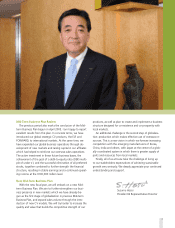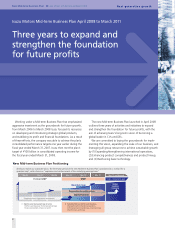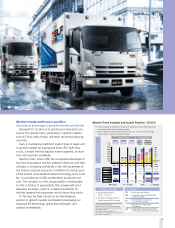Isuzu 2008 Annual Report Download - page 16
Download and view the complete annual report
Please find page 16 of the 2008 Isuzu annual report below. You can navigate through the pages in the report by either clicking on the pages listed below, or by using the keyword search tool below to find specific information within the annual report.
14
「
Interview with the Management n Isuzu Motors Limited Annual Report 2008
3. Interview with
Naotoshi Tsutsumi
Executive Vice President
(Division Executive, Manufacturing Division)
Q1: What is Isuzu’s current production capacity by region?
A1:
For CVs, our global capacity is 330,000 units. Regionally, our
capacity is 160,000 units in Japan (including completed vehicles and
KD shipments for general overseas markets), 80,000 units in China,
40,000 units in Asia (Thailand and Indonesia), and 50,000 units in
Europe (Russia and Turkey). For LCVs, our global capacity is 370,000
units, including contract manufacturing. Regionally, our capacity is
250,000 units in Thailand, 20,000 units in China, and 100,000 units in
other regions (South and Central America, Africa, Asia, Oceania, etc.).
Q2: How do you plan to achieve the production capacity
targets in the new Mid-term Business Plan of 350,000 CVs
and 420,000 light CVs?
A2:
In both CVs and LCVs, our current Mid-term Business Plan calls
for expanding volume in regions exporting finished vehicles and KD
vehicles. These production bases are in Japan for CVs and in Thailand
for LCVs. Boosting production capacity in these areas will be key, and
we are planning to make capital investments of ¥120.0 billion over
three years.
Q3:
How would you characterize Isuzu’s production tech-
nology and production quality, and what information can
you provide about current and future initiatives?
A3:
Isuzu’s production technology is characterized by close links to
the production site and the pursuit of minimum investments for maxi-
mum efficiency. We hold technology presentations every two months
to increase our overall technology level, and for the past several years
we have been pursuing *kit production with an idea of *kit shipment
(inventory reduction in the broad sense). In terms of production qual-
ity, we assign high value to information from the market and reflect it
in our capital investments. Additionally, we are working to standard-
ize the quality of Isuzu products produced worldwide by implementing
the three steps of preventing defects in manufacturing, keeping
defects from being sent to subsequent production processes, and
keeping defects from being shipped through IMM (Isuzu Manufacturing
Management).
Q4: What is Isuzu’s current diesel engine (DE) production
capacity by region?
A4:
Our global capacity is 1,470,000 units. Regionally, our capacity
is 580,000 units in Japan, 300,000 units in Asia (Thailand and
Indonesia), 40,000 units in China, 330,000 units in Europe (Poland),
and 220,000 units in North America (the United States).
Notes:
* Kit shipment: The practice of picking out and lining up the necessary parts in the
order in which they will be used, and supplying them to the production line as a kit.
* Kit production: A production system designed to reduce inventory and load on the
main production line by organizing work in terms of functional modules and sub-
assembly modules.
























